No Manning Required Ship
 |
| Concept design for NOMARS Defiant unmanned ship |
Claude Summary
Gemini Brief on DARPA program and the Navy:
NOMARS Program Goals:
- Uncrewed Design: Unlike traditional USVs designed with potential crew needs in mind, NOMARS prioritizes a "clean-sheet" approach. It completely removes human presence from the equation, allowing for a radically different ship design [1, 3].
- Enhanced Performance: By eliminating crew requirements, NOMARS aims to achieve significant advantages. This includes potentially larger size (with no need for crew quarters), lower costs (reduced life support systems), increased reliability (fewer failure points from human error), and improved survivability (no crew to endanger) [3].
- Extended Operations: The program seeks a USV that can operate for a year between maintenance cycles, significantly reducing downtime and operational costs compared to crewed vessels [4].
Coordination with the Navy:
- Early Involvement: The Navy is closely involved in the NOMARS program, even though it's a DARPA initiative. This ensures the Navy understands the project's design and potential benefits, facilitating a smoother transition if the technology proves successful [2, 4].
- Future Integration: DARPA aims to transition the knowledge and technology developed in NOMARS to the Navy after successful testing. This could lead to the Navy incorporating unmanned vessels with these capabilities into their future fleet architecture [4].
- Complementary Programs: The Navy has its own USV programs, but NOMARS focuses on a completely uncrewed design, pushing the boundaries of what's possible. The Navy's programs might focus on adapting existing crewed vessel designs for unmanned operation [2].
Overall, DARPA's NOMARS program and the Navy have a collaborative relationship. The program is paving the way for next-generation unmanned ships, while the Navy is strategically positioned to potentially integrate this technology into its future fleet.
Gemini SERCO Group in Brief
SERCO Group is playing a leading role in the development of unmanned surface vessels (USVs) through their involvement in the Defense Advanced Research Projects Agency (DARPA) NOMARS program, which stands for "No Manning Required Ship". Here's a breakdown of their involvement:
- Prime Contractor: SERCO is the main contractor for the entire NOMARS program. This means they're responsible for managing the project, overseeing the design and construction of the vessel, and ensuring it meets DARPA's requirements [1, 2].
- Design Lead: Their team, including specialists like Ryan Maatta (Lead Engineer), is credited with designing the NOMARS vessel, currently named "Defiant" [4].
- Technology Expertise: SERCO brought their Model-Based Systems Engineering (MBSE) know-how to the project. This helps streamline design and reduce technical risks [5].
- Partnerships: To complete the vessel, SERCO collaborated with various companies like Nichols Brothers Boat Builders (construction) and Caterpillar (engines) [2].
Overall, SERCO is at the forefront of developing this unmanned maritime technology for DARPA. Their aim is to build a highly reliable and functional USV that can perform missions at sea without any crew on board.
Here are a few resources where you can find more information about SERCO Group:
- Serco Official Website: The official website of Serco Group https://www.serco.com/ provides a good starting point. You can explore their services, news, and company information.
- Wikipedia: The Serco Group page on Wikipedia https://en.wikipedia.org/wiki/Serco offers a comprehensive overview of the company's history, operations, and areas of expertise.
- Financial Reports: For a more in-depth look at Serco's financial performance and business structure, you can check out resources like AnnualReports.com https://www.serco.com/investors/results-centre or financial news websites.
=======================================================================
The No Manning Required Ship (NOMARS) program seeks to design a ship that can operate autonomously for long durations at sea, enabling a clean-sheet ship design process that eliminates design considerations associated with crew. NOMARS focuses on exploring novel approaches to the design of the seaframe (the ship without mission systems) while accommodating representative payload size, weight, and power.
NOMARS aims to challenge the traditional naval architecture model, designing a seaframe from the ground up with no provision, allowance, or expectation for humans at sea. By removing the human element from all ship design considerations, the program intends to demonstrate significant advantages, to include size, cost, at-sea reliability, survivability to sea-state, and survivability to adversary actions such as stealth considerations and resistance to tampering. The program also will strive for greater hydrodynamic efficiency via hull optimization without requirements for crew safety or comfort.
DARPA’s NOMARS program looks to chart a course for future uncrewed vessels - Naval News
The Defense Advanced Research Projects Agency (DARPA) No Manning Required Ship (NOMARS) program has been conceived to build and test an uncrewed X-ship demonstrator designed to operate autonomously for extended periods without any human intervention or underway maintenance. Serco was last year selected to deliver Phase 2 of NOMARS ahead of a rival Gibbs & Cox team following completion of Phase 1B preliminary design activities.
Launched by DARPA’s Tactical Technology Office in 2020, NOMARS has been established to build and demonstrate a medium unmanned surface vessel (MUSV) that can go to sea and perform missions with unprecedented reliability and availability, while also carrying a significant payload. The intention is that the NOMARS vessel and sub-systems should be able to operate for missions lasting many months at a time with no manned interventions between yearly maintenance cycles.
According to DARPA, the program seeks to challenge the traditional naval architecture model by designing a ‘clean-sheet’ seaframe “with no provision, allowance, or expectation for humans at sea”.
“By removing the human element from all ship design considerations, the program intends to demonstrate significant advantages, to include size, cost, at-sea reliability, survivability to sea-state, and survivability to adversary actions such as stealth considerations and resistance to tampering. The program also will strive for greater hydrodynamic efficiency via hull optimization without requirements for crew safety or comfort.”
DARPA
Serco’s Phase 2 contract, worth up to $68.5 million if all options are exercised, was announced by DARPA in August 2022. The company’s NOMARS solution, named Defiant, is a 210-tonne MUSV-class design: renders released by DARPA and Serco show Defiant to be a slender monohull with a prominent arch-mast structure amidships. The design will integrate distributed hybrid power generation, podded propulsors, and high-capacity batteries.
The Serco team is led by the company’s Marine Engineering Operations division, which brings resident naval architecture and marine engineering expertise from the acquisition of the Naval Systems Business Unit of Alion Science and Technology Corporation in 2019. This same business has its heritage in John J. McMullen and Associates (JJMA), which was acquired by Alion in 2005.
Serco’s team also includes Submergence Group (a pioneer in USV control and autonomy through extensive development and testing of IBM’s Mayflower Autonomous Ship) and Metron (developer of a smart health monitoring system that acts as a ‘digital chief engineer’ responsible for monitoring, maintaining, and optimizing vessel health over long duration voyages). Construction of Defiant will be undertaken by Nichols Brothers Boat Builders located in Freeland, Washington; other members of the industry alliance include Beier Integrated Systems, Caterpillar Marine, DRS Naval Power Systems, Thrustmaster of Texas, and Integer Technologies.
MUSVs are being considered by the US Navy as long-range ISR platforms to extending the ‘sensor horizon’ of larger manned combatants into contested or high-threat areas without risking the lives of crews. The NOMARS Defiant platform has been designed to drastically decrease the navy’s cost per mission hour with a reduced platform size, lower maintenance costs, and extended time on station.
The Defiant design was developed by Serco using a proprietary Design Space Exploration (DSX) toolset that enabled the company to evaluate spaces with a variety of parameters, and output multiple of ship designs to meet a diverse set of performance objectives and constraints. Serco used the DSX tool to iterate a series of ship designs, subsequently refining these to finalise its Defiant concept.
To achieve the very high levels of reliability demanded by the NOMARS program, Serco has adopted a philosophy of graceful degradation in order that there is sufficient system-level redundancy to tolerate system casualties over time and still meet full system requirements. For example, the major system components of the Defiant design are modularised, so repairs can be conducted with equipment typically found in yacht yards worldwide. This maintenance philosophy also supports a rapid turnaround. NOMARS Phase 2 is planned to culminate with a final three-month at-sea demonstration event, currently planned for late 2024/early 2025. It is anticipated that the Defiant X-ship demonstrator will subsequently join other MUSVs under evaluation by the US Navy for fleet operations.
Richard Scott is a well-known UK-based writer on the Royal Navy and other naval forces worldwide.
Apr 6, 2023 Second day at Sea Air Space 2023. In this video NavalNews cover
- 00:46 - General Atomics Long Range Maneuvering Projectile (LRMP)
- 04:38 - SERCO NOMARS (No Manning Required Ship) USV project
- 06:37 - Metal Shark LRUSV for the USMC
- 07:39 - HERO 120 loitering munition for the LRUSV
- 07:48 - ALSMEAR SeaExplorer glider
===================
DARPA is moving into Phase 2 of the No Manning Required Ship (NOMARS) program, which seeks to build and demonstrate a revolutionary new medium unmanned surface vessel (MUSV) that can go to sea and perform missions with unprecedented reliability and availability, while carrying a significant payload. The agency selected Serco Inc.’s design to move forward at the conclusion of Phase 1.
NOMARS took a clean-sheet approach to ship design, holding firmly to the requirement that there will never be a human on board the vessel while it is at sea – including during underway replenishment (UNREP) events. By eliminating all constraints and requirements associated with humans, NOMARS opened up the design space to novel ship configurations and capabilities that could never be considered for crewed vessels.
NOMARS is also pushing the boundaries on ship reliability. Because there is no crew on board to perform maintenance, NOMARS required new approaches for power generation, propulsion, machinery line-up, and control schemes to ensure continuous functionality throughout a long mission in all weather, temperature, and sea states.
“NOMARS plans to demonstrate a next-generation completely unmanned ship that will enable entirely new concepts of operations,” said Gregory Avicola, program manager in DARPA’s Tactical Technology Office. “We will enable methods of deploying and maintaining very large fleets of unmanned surface vessels that can serve as partners, across the globe, for the larger crewed combatants of the U.S. Navy.”
In Phase 1, Serco developed a new Design Space Exploration (DSX) toolset that can evaluate spaces with a variety of parameters and outputs millions of ship designs to meet a diverse set of performance objectives and constraints. Serco used their DSX tool to create a set of ship designs ranging from 170-270 metric tons, then refined those into a single ship for the preliminary design review, which the company dubbed Defiant. In Phase 2, Serco will finalize ship design, build the ship, and work through a series of rigorous testing activities before taking it to sea for a three-month demonstration event. Serco is working with Beier Integrated Systems LLC, Caterpillar, DRS Naval Power Systems Inc., ICE FLOE LLC (dba Nichols Brothers Boat Builders), Metron Inc., Serco Inc. (div Maritime Engineering Operations), Submergence Group LLC, and Thrustmaster of Texas Inc. on the project.
Defiant will be the first of its kind. The 210-metric ton MUSV-class ship aims to maximize performance, reliability, and maintenance efficiency while still carrying significant payload at tactically useful ranges. The goal is to achieve ultra-reliability objectives by integrating distributed hybrid power generation, podded propulsors, and high-capacity batteries. A key philosophy of NOMARS is “graceful degradation,” which allows individual equipment to fail over time by having enough system-level redundancy to meet full system requirements at speeds of at least 15 knots after one year at sea. The major system components of the selected design are modularized, so repairs can be conducted with equipment typically found in yacht-yards worldwide. This maintenance philosophy supports rapid turnaround, allowing the ships to spend a majority of their lifetime at sea performing missions.
Image Caption: Concept design for NOMARS Defiant unmanned ship.
DARPA's Defiant Fully Uncrewed Demonstrator Ship Will Hit The Seas Later This Year
Plans to test a new uncrewed surface vessel are making waves, with the company heading the project targeting the end of this year to put its demonstrator in the water. Serco Inc.'s Defiant testbed has been designed from the ground up with the knowledge that there will never be a human onboard while it's at sea. Conceived as being capable of operating autonomously for months to years with minimal maintenance, the vessel is already being eyed by the Navy as a path to fielding a fleet of missile-laden drone boats in the future.
Defiant is being procured under the Defense Advanced Research Projects Agency's (DARPA) No Manning Required Ship (NOMARS) program, which aims to field a new medium uncrewed surface vessel (MUSV) prototype. The NOMARS program was launched in 2020, and Serco's involvement in it stretches back to that time.
In 2022, the company was awarded a $68.5 million total-value contract to build, test, and demonstrate its solution as the prime contractor. This is all prior to the start of more rigorous at-sea testing, which a representative for Serco confirmed to The War Zone on the floor of the Navy League's Sea Air Space symposium this week is scheduled to start in January 2025.

Detailed specifications on Defiant's overall proportions have not been released. However, we know that it is a 210-metric ton, medium-sized USV design, per DARPA.
In executing what DARPA calls a "clean-sheet ship design process" — i.e., in designing a vessel meant to be totally uncrewed at sea, including during underway replenishment events, and requiring limited maintenance over long stretches of time — Serco, along with various industry partners, has explored multiple ways in which the space saved from removing human operators could be utilized. The demonstrator itself is being built by the Washington state-based shipbuilder Nichols Brothers Boat Builders, for which it was awarded a contract in October 2023.
Although specific mission sets for the testbed have not been specified by DARPA, it does note that it should be able to carry "significant payload at tactically useful ranges."
At the front of a model of Defiant displayed at Sea Air Space 2024, for example, there is an angled missile launch system, which is likely what BAE Systems is currently marketing as the Adaptable Deck Launching System, or ADL. A deck-mounted angled launcher, ADL offers vessels with limited below-deck space Mark 41 vertical launch system (VLS)-like capability. The trade-off of ADL is the significant surface-area it takes up on deck for the launch cells is provides; however, given that Defiant has been optimized for maximizing available deck space by removing considerations associated with crews, this is a logical pairing.e.
ADL is a modular design and is currently offered in two-, four-, and eight-cell configurations; with the four-tube version shown on the Defiant model. You can read all about ADL in our previous profile on it linked her
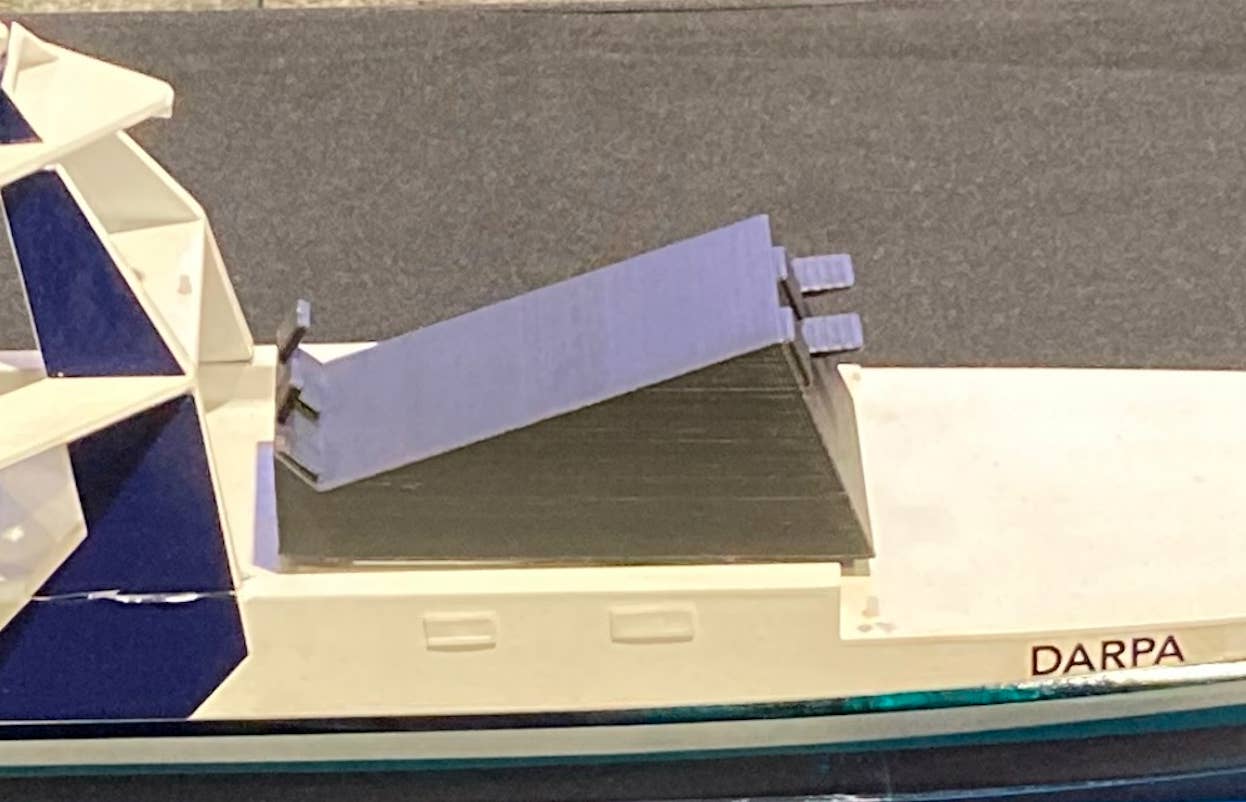
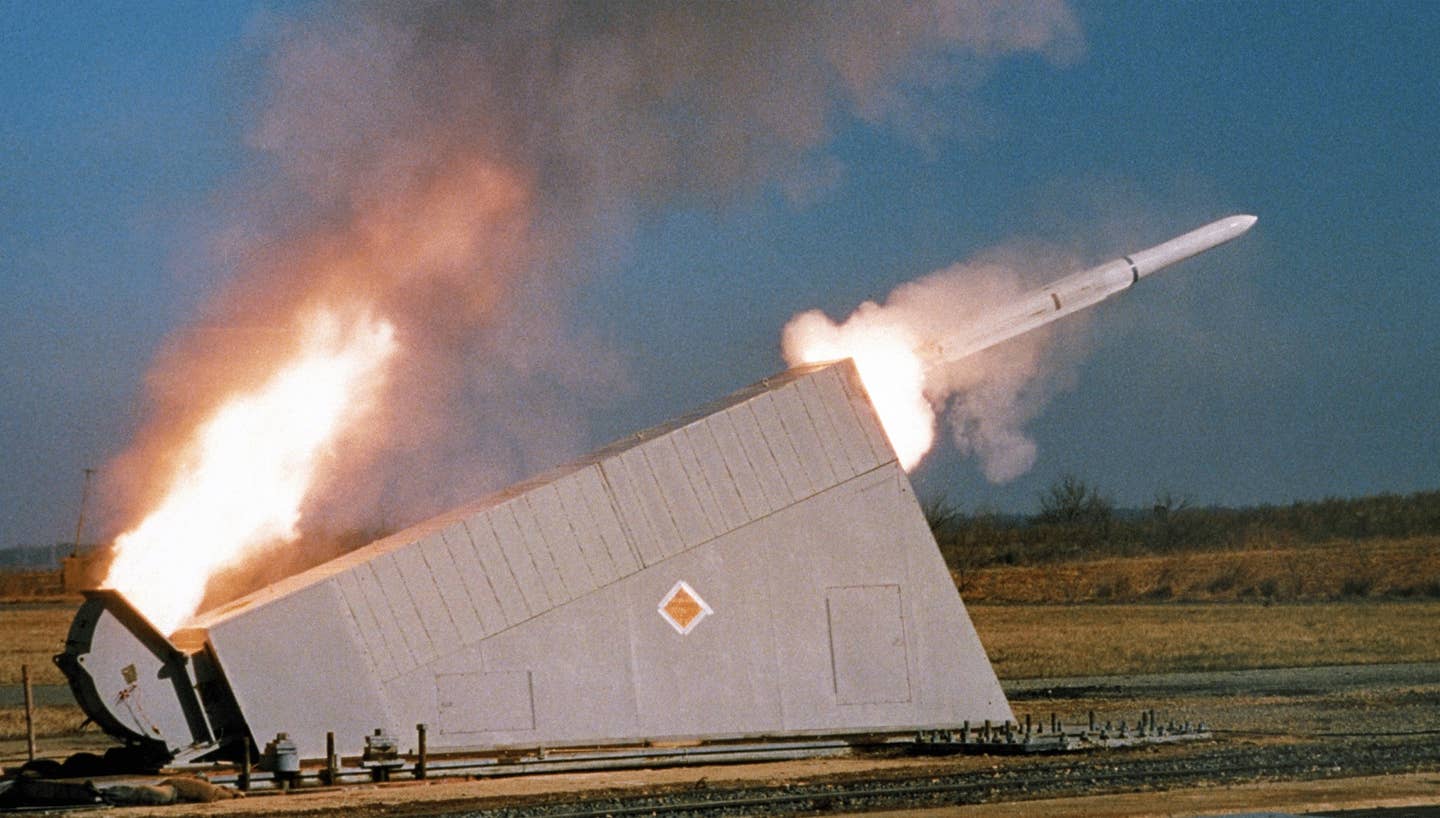
Utilizing ADL's Mk 41-derived design means that Defiant would be able to launch a wide variety of weapons, including surface-to-air missiles, anti-submarine rockets, and anti-ship and land-attack missiles that are all in the Navy's current inventory.
It should be noted that Serco has already completed some initial design work on a larger derivative of Defiant called Dauntless. A model of that USV shown on the floor of Sea Air Space depict it sporting four, four-tube ADLS, for a total of 16 cells.
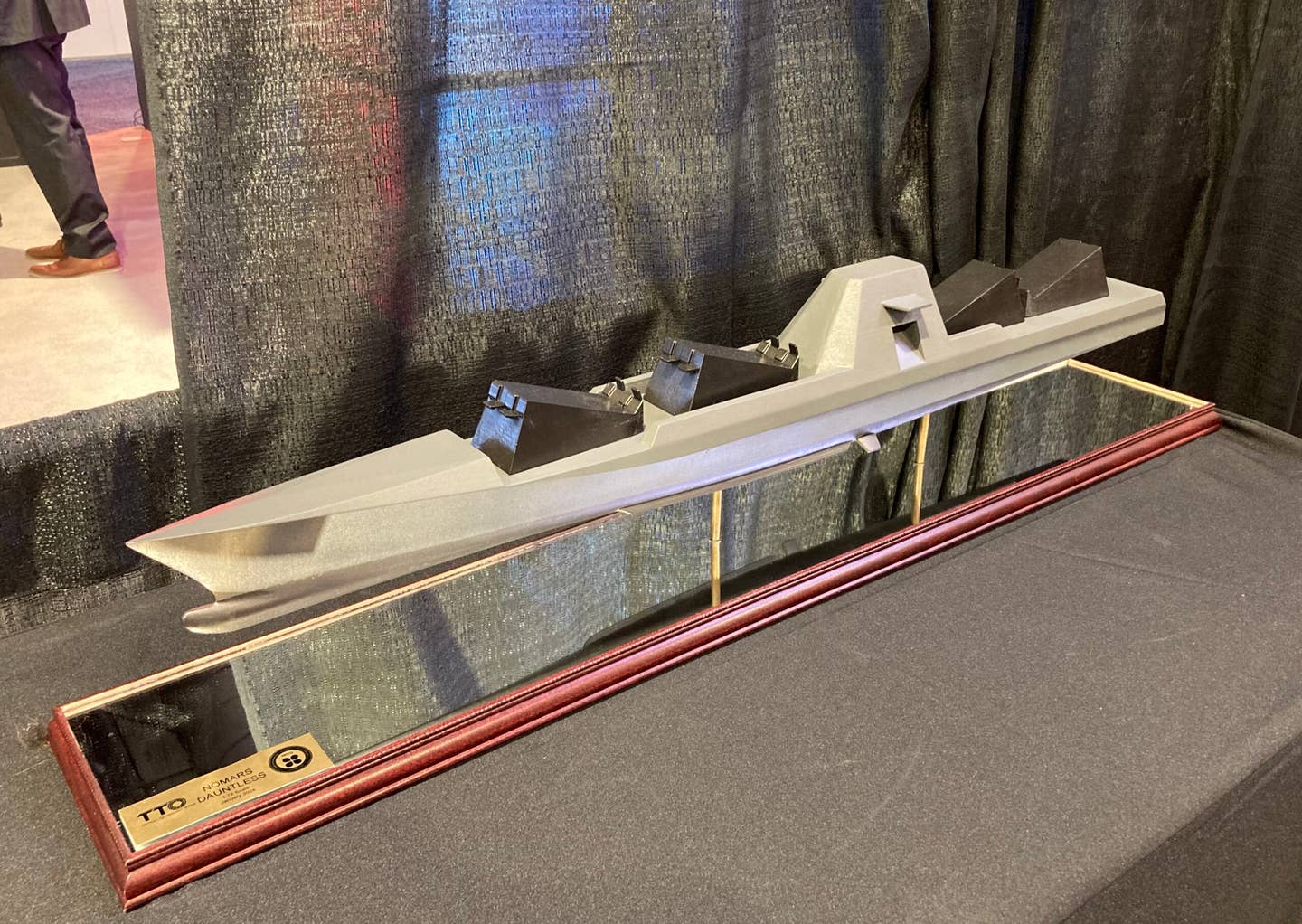
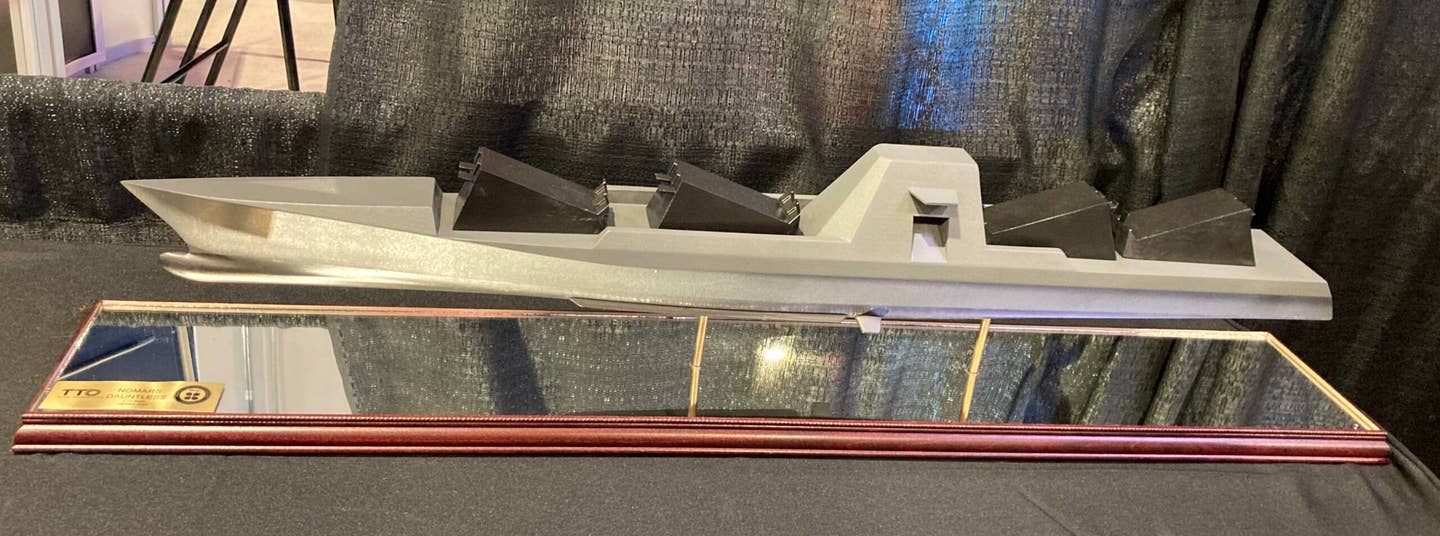
In addition to its missile carrying capability, Serco envisions Defiant carrying other payloads, too. To the back of the model, we see it sporting a shipping container, which could be used to store all-manner of assets; including containerized launchers for drones, electronic warfare and intelligence-gathering systems, communications suites, towed sonars, and more.
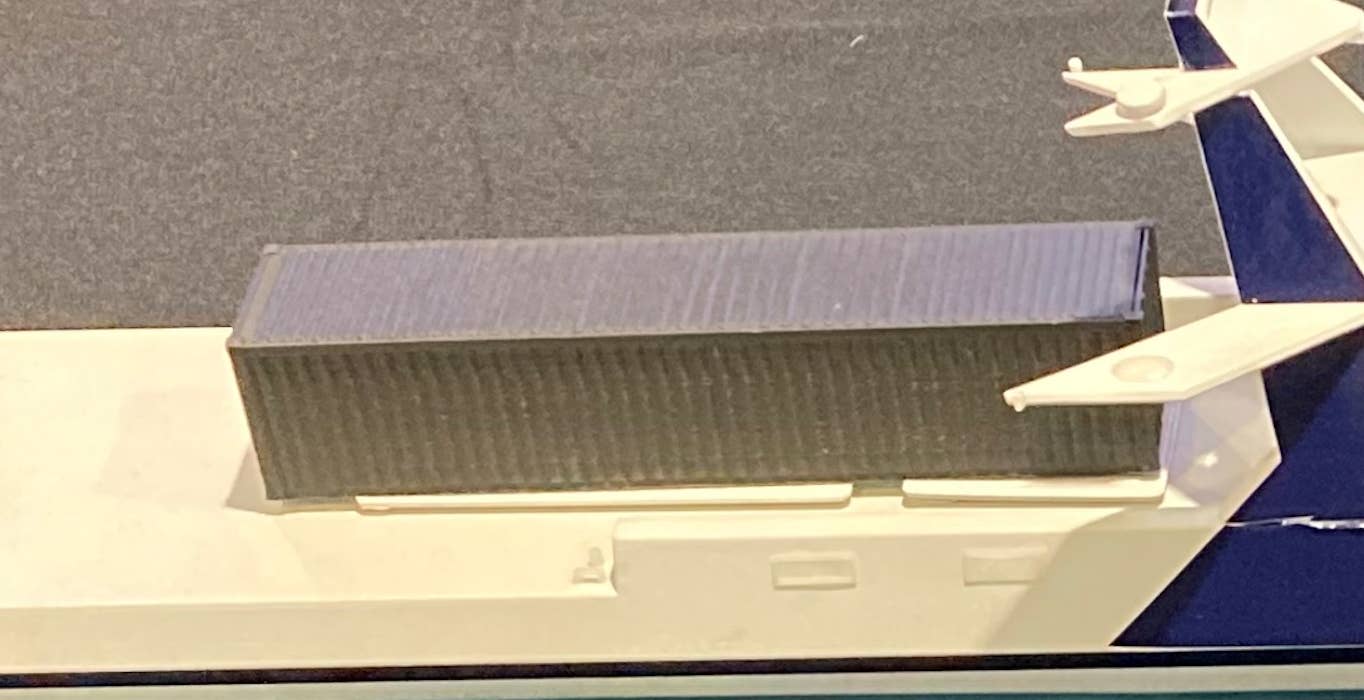
In previous concept videos for its MUSV, Serco has depicted Defiant undertaking humanitarian relief operations; delivering food and aid shipments to strategic locations.
There is also potential for it to do logistics work in a military context, too; DARPA has a separate program on this called Sea Train, which you can read more about here.
In terms of propulsion, Defiant is set to feature distributed hybrid power generation, podded propulsors, and high-capacity batteries, per DARPA's requirements for improving "hydrodynamic efficiency via hull optimization."
As a specific requirement of the NOMARS program, and in order to achieve high levels of reliability, Defiant will adopt DARPA's "graceful degradation" concept. This allows for "individual equipment to fail over time by having enough system-level redundancy to meet full system requirements at speeds of at least 15 knots after one year at sea."
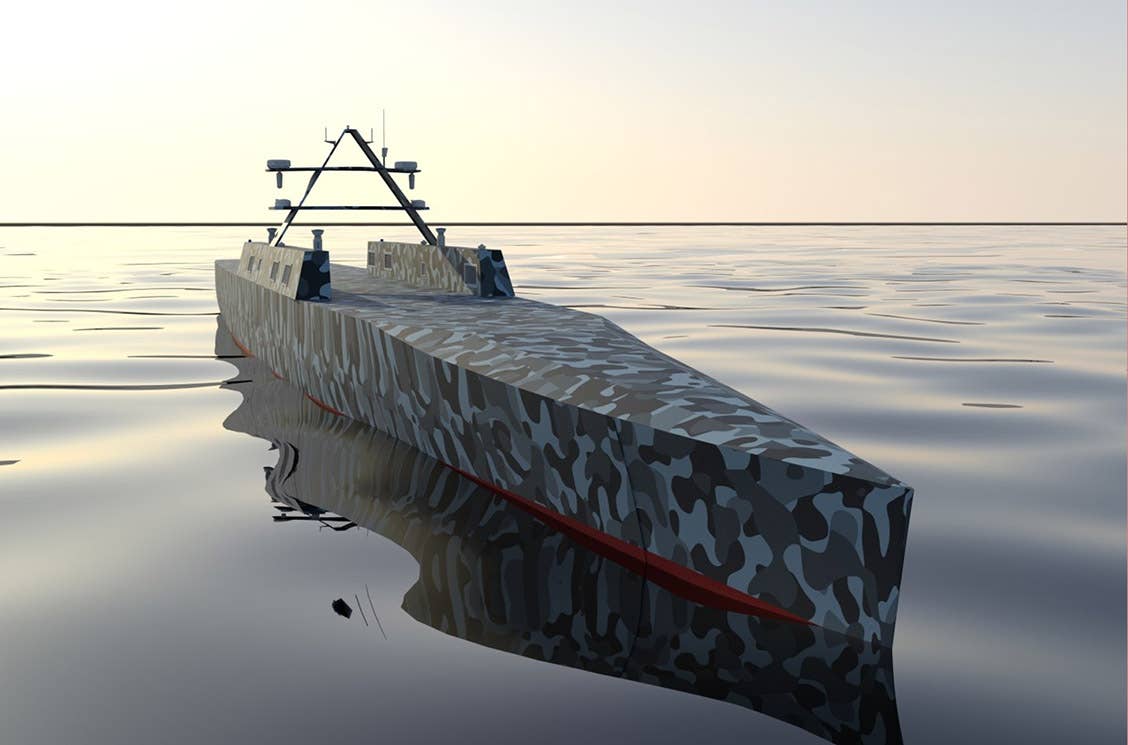
Overall, the demonstrator's design and low-maintenance costs — maintenance on it can be performed at small yacht yards, for example — is meant to significantly decrease the Navy’s cost per mission hour, Naval News reports.
Serco's representative confirmed that the price-tag for the demonstrator, not including any add-on mission systems, is approximately $25 million.
Following the completion of at-sea trials next year, which DARPA has previously noted will last three-months in total, the demonstrator will most likely pass to the Navy. To date, several of DARPA's experimental medium-sized USV programs have been transitioned to Navy in the forms of Sea Hunter and Seahawk. Those MUSVs are now part of a wider USV fleet which the Navy has been experimenting with.
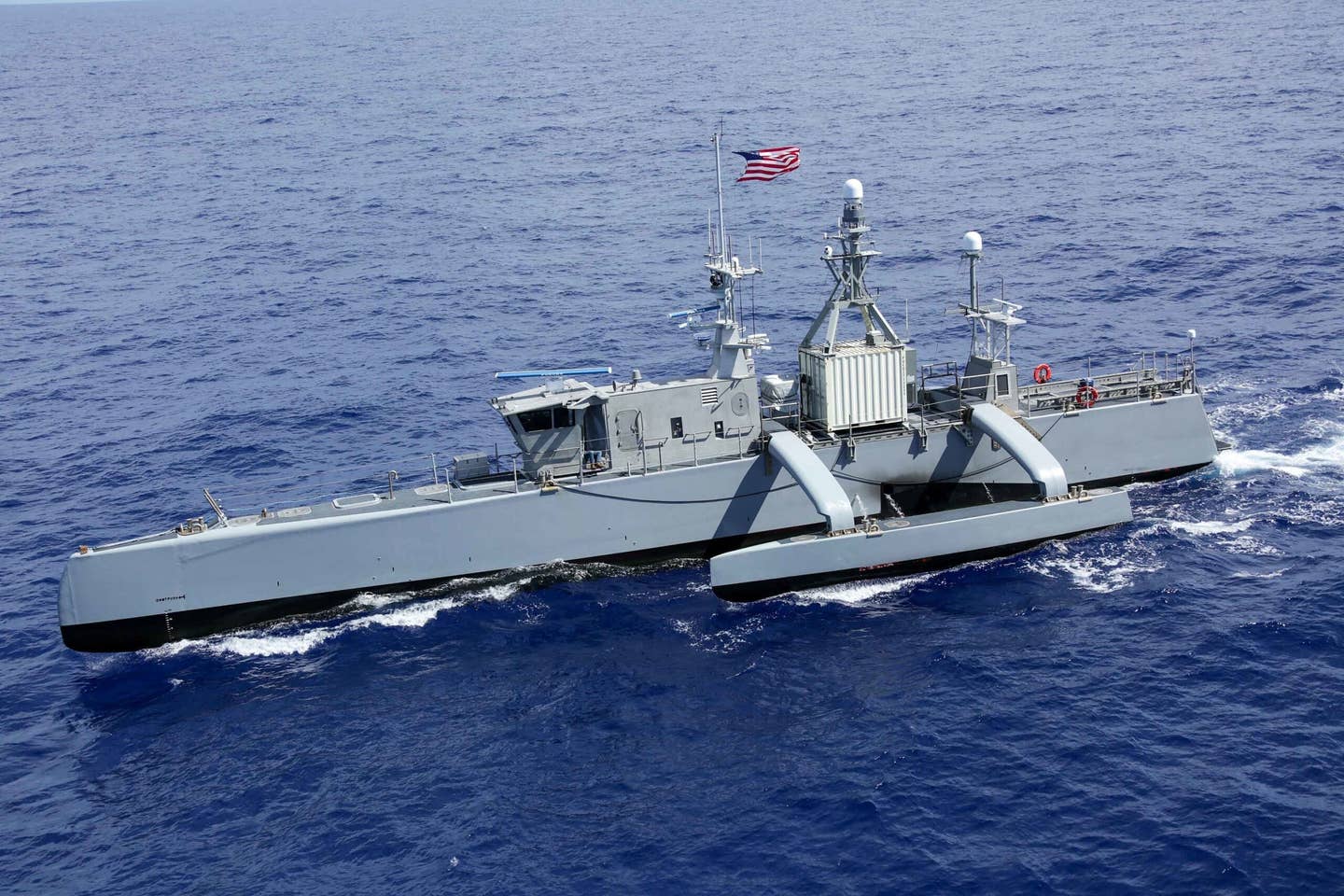
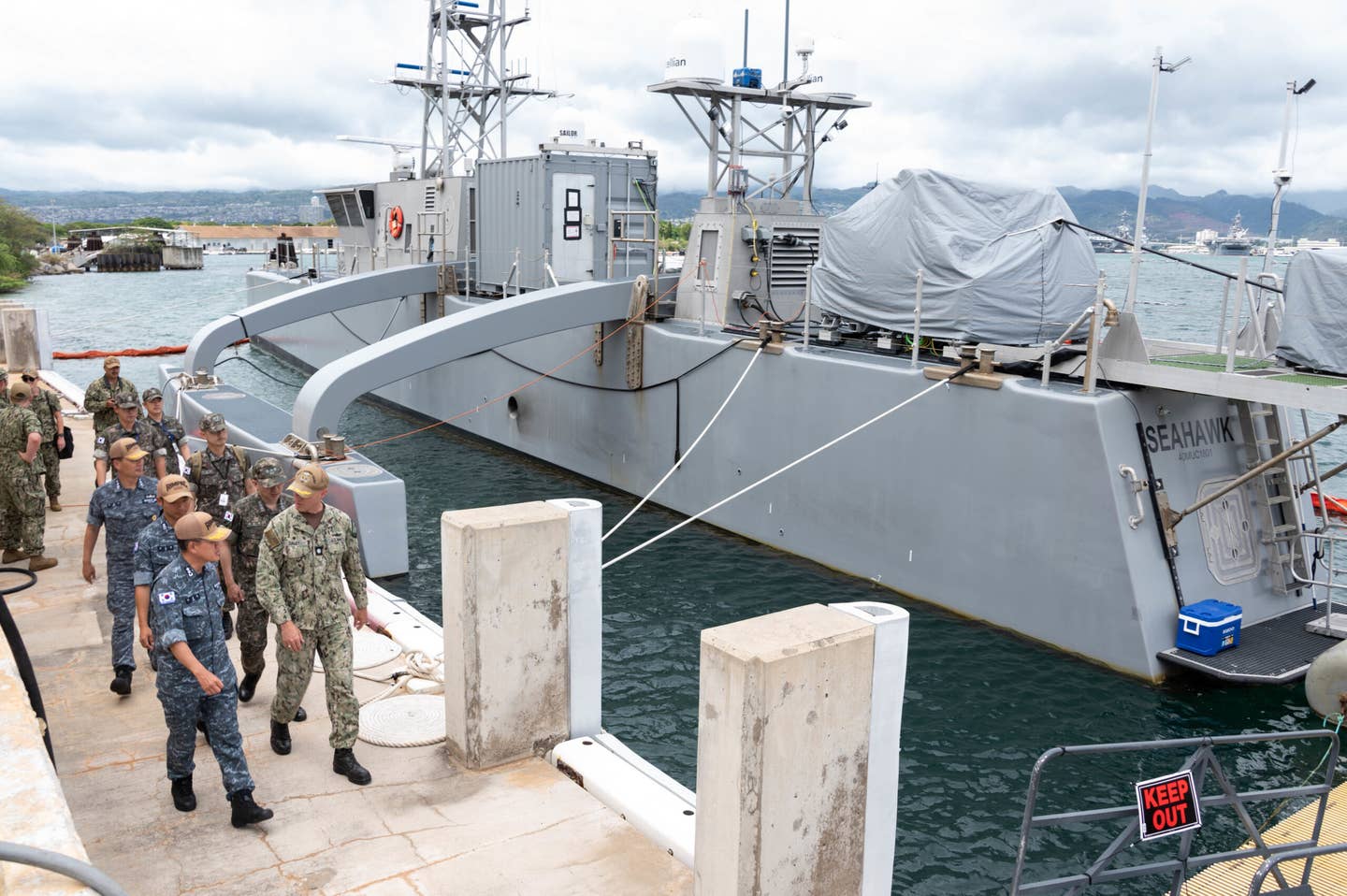
In the case of Defiant, the Department of Defense has been vocal about the potential benefits it could offer the Navy going forward, particularly in terms of adding additional strike platforms working in conjunction with crewed assets.
In the DoD's Fiscal Year 2025 budget request, it specifically states that the "capability will enable disaggregated persistent USVs, allowing the surface fleet to credibly threaten peer adversaries and negate their investments in high-cost weapon systems designed to counter large naval targets such as aircraft carriers." Success with the NOMARS program would create "a pathway to allow a distributed lethality concept to become viable: small ships, in large numbers, each of which is individually low-cost and low-value, but in aggregate presents a significant deterrent [to adversaries]."
In addition, there are also advantages in terms of the ease with which the design could be constructed in large numbers in order to fulfill that need. Construction of the design does not need to be limited to established shipyards; as Serco's representative noted on the Sea Air Space 2024 floor, it could conceivably be built at locations like railworks, if needed. Having access to an easily producible MUSV would be a huge boost to the Navy, particularly amid serious concerns regarding the rate of U.S. ship production, notably in relation to adversaries like China. Just the ability to quickly produce relatively capable vehicles and weapons, especially during a crisis, at relatively low cost, is becoming a major advantage the Navy is seeking to obtain across domains.
We will be keeping our eyes peeled for when Defiant takes to the water for the first time later this year.
Serco Team to Enter 2nd Phase of DARPA’s Unmanned Surface Vessel Project
Home News Serco Team to Enter 2nd Phase of DARPA’s Unmanned Surface Vessel Project
Serco Group‘s U.S. subsidiary and industry partners will begin the second leg of an unmanned surface vessel development and demonstration program spearheaded by the Defense Advanced Research Projects Agency.
As part of Phase 2 of the No Manning Required Ship program, DARPA said Monday the team’s medium USV concept dubbed Defiant is expected to undergo a series of tests following design completion and ship construction.
Efforts will culminate in a three-month sea demonstration event to determine the MUSV’s reliability in performing tactical missions while carrying a significant payload.
Highlighting the initiative’s goals, Gregory Avicola, program manager in DARPA’s Tactical Technology Office, said, “We will enable methods of deploying and maintaining very large fleets of unmanned surface vessels that can serve as partners, across the globe, for the larger crewed combatants of the U.S. Navy.”
The upcoming 210-metric ton MUSV-class ship is envisioned to feature distributed hybrid power generation as well as utilize podded propulsors and high-capacity batteries. Defiant’s major system components are also modularized to ensure compatibility with common repair equipment.
Work is being conducted by Serco Inc. and its industry collaborators: Beier Integrated Systems, DRS Naval Power Systems, Nichols Brothers Boat Builders, Metron, Submergence Group and Thrustmaster of Texas Inc.
The team finished the conceptual design phase of the DARPA program in September 2021.
Nichols Brothers Wins Contract to Build NOMARS Uncrewed Vessel
Freeland, Wash. shipbuilder Nichols Brothers Boat Builders (NBBB) announced it has been awarded a contract to construct an uncrewed autonomous vessel for the U.S. Department of Defense's research and development agency.
The No Manning Required Ship (NOMARS) project was awarded by Serco North America, the prime contractor and designer of the vessel, for the Defense Advanced Research Projects Agency (DARPA).
The program aims to revolutionize naval operations by designing a ship that can operate autonomously for extended periods at sea without an onboard crew.
“NOMARS plans to demonstrate a next-generation completely unmanned ship that will enable entirely new concepts of operations,” said Gregory Avicola, program manager in DARPA’s Tactical Technology Office. “We will enable methods of deploying and maintaining very large fleets of unmanned surface vessels that can serve as partners, across the globe, for the larger crewed combatants of the U.S. Navy.”
Gavin Higgins, CEO of Nichols Brothers Boat Builders, said, "The NOMARS program envisions a future where maritime operations can benefit from enhanced efficiency and performance through autonomous technology. This initiative aligns with our dedication to pushing the boundaries of what's possible in boat building. Our talented team of engineers, designers, and technicians is eager to demonstrate our expertise in developing cutting-edge vessels.”
Uncrewed vessel: DARPA’s Defiant to start sea trials
As per Serco, the vessel would be capable of operating autonomously in the sea for a long time.
A medium uncrewed surface vessel (MUSV) prototype being built for the US Navy is expected to hit the seas this year.
The vessel is being procured under the No Manning Required Ship (NOMARS) program of the Defense Advanced Research Projects Agency (DARPA).
Called Defiant, the vessel would be capable of operating autonomously for a long time. With a requirement of minimal maintenance, the vessel is expected to have wide-ranging utility for the Navy.
Ship specifications
The 210-metric ton MUSV-class ship is expected to be the first of its kind with maximum performance, reliability, and maintenance efficiency while still carrying significant payload at tactically useful ranges. The Navy plans to use it as a missile-laden drone boat.
The goal is to achieve ultra-reliability objectives by integrating distributed hybrid power generation, podded propulsors, and high-capacity batteries.
The major system components of the selected design are modularized, so repairs can be conducted with equipment typically found in yacht yards worldwide. This maintenance philosophy supports rapid turnaround, allowing the ships to spend the majority of their lifetime at sea performing missions.
Large fleets of uncrewed vessels
DARPA plans to deploy and maintain very large fleets of unmanned surface vessels that can serve as partners, across the globe, for the larger crewed combatants of the US Navy.
Serco will finalize ship design, build the ship, and work through a series of rigorous testing activities before taking it to sea for a three-month demonstration event.
The price for the demonstrator is around $25 million without including any add-on mission systems, according to Serco. The vessel is also aimed at decreasing the Navy’s cost per mission hour with a reduced platform size, lower maintenance costs, and stay on mission longer.
Defiant is likely to be equipped with surface-to-air missiles, anti-submarine rockets, and anti-ship and land-attack missiles.
The vessel will have four tubes of deck-mounted angled launchers, for a total of 16 cells according to the initial design work provided by Serco.
According to Serco, medium uncrewed surface vessel platforms are envisioned by the Navy as long-range sensing platforms extending the reach of larger manned combatants into contested or high-threat areas without risking the lives of crew members.
These platforms enable virtually embarked warfighters to command the operational theater with an enhanced networked picture of the battlespace. A fleet comprising these smaller autonomous platforms will increase total deployed capabilities while decreasing fleet cost and reducing risk to service members.
Sea trials
Following the completion of at-sea trials next year, which DARPA has previously noted will last three-months, the demonstrator will most likely pass it on to the Navy. To date, several of DARPA’s experimental medium-sized USV programs have been transitioned to Navy in the forms of Sea Hunter and Seahawk. Those MUSVs are now part of a wider USV fleet which the Navy has been experimenting with, reported The War Zone.
 The NOMARS Defiant
X-Ship design developed by Serco is a radical departure from
traditional designs, representing the next step for the US Navy’s
advancement toward a fleet of USVs. The platform was designed from the
keel up as a truly autonomous vessel with no provisions for onboard
manning and stringent requirements for year-long, high reliability
operations at sea without human intervention. Serco’s design includes a
reimagined maintenance philosophy that reduces time in port and keeps
the vessel underway and operational for unprecedented periods of time.
This highly reliable vessel serves to demonstrate the art of the
possible for cost-effective, long endurance naval drone ships.
The NOMARS Defiant
X-Ship design developed by Serco is a radical departure from
traditional designs, representing the next step for the US Navy’s
advancement toward a fleet of USVs. The platform was designed from the
keel up as a truly autonomous vessel with no provisions for onboard
manning and stringent requirements for year-long, high reliability
operations at sea without human intervention. Serco’s design includes a
reimagined maintenance philosophy that reduces time in port and keeps
the vessel underway and operational for unprecedented periods of time.
This highly reliable vessel serves to demonstrate the art of the
possible for cost-effective, long endurance naval drone ships.


No comments:
Post a Comment